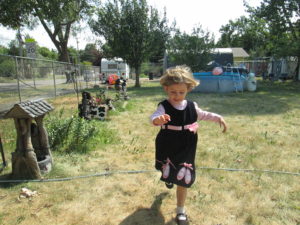
This interview was actually conducted long ago, but the information is still valid today.
An entirely new group of young children can now benefit from the same recipes and ideas!
Small children need great nutrition, as their minds and bodies are growing.
What is Family Style Meal Service?
Family style meals are where the food is placed on the table in serving bowls. Each person takes what they want, and then passes the serving bowl to the next person. Through this type of service, children learn to share, develop hand-eye coordination and motor skills. Small children will need some assistance in serving and passing the bowls of food, but can certainly express a preference for which foods they want on their plates. This lets them take responsibility for deciding what they will eat and how much they will eat.
Feeding the Small Ones Right
Small people have their own special dietary needs, said Pat Anderson, Executive Director of Nutrition for North Dakota Daycare Children.
“The first two years, we are setting the building blocks for a lifetime of eating,” said Anderson. “You want to formulate good eating habits, so you want to expose them to a variety of foods.”
Children are in charge of what and how much they eat; parents are in charge of where they eat, when they eat, and how the food is prepared. This division of responsibility is important, said Anderson.
“The child’s role is probably very challenging for us,” said Anderson. “It is up to the child to choose which of the foods served they will eat and how much they will eat.”
“You cannot make a toddler eat something,” said Anderson. “It is a losing battle.”
The important role of the family is teaching the child to eat at scheduled times, said Anderson. “As a child moves from infant to toddler, they are exposed to the family meal structure. Plus snacks—they have small tummies and need to eat small portions.”
The danger is when toddlers are permitted to panhandle treats between scheduled meal and snack times. “If you are allowing the child to panhandle you and demand a cookie an hour before mealtime, they are not hungry for the meal,” said Anderson.
Do not give up on introducing new foods to a child, said Anderson. In a recent study, they found that people gave up on feeding a new food to toddlers after four exposures, said Anderson. “They are learning to like,” said Anderson. “They are learning new textures, new tastes. They have to have frequent exposures to it. Often it can take fifteen or twenty exposures before they like it.”
Serving meals family style is the best choice, said Anderson. The child can decide which of the foods they wish to eat and how much of each they will eat. “It is not uncommon there will be days they will only eat a bite from two of the foods you offer. Other days, they will surprise you with how much they will eat. As long as they are growing normally and are healthy, they are eating enough,” said Anderson.
It is important to make sure there is something on the table that you know the toddler will like, said Anderson. Offer them common staples, such as bread and milk, a protein source, a starchy food, and be sure to include fruits and vegetables in the meal. Toddler servings are very small. For tots, one to two tablespoons is a serving, or about ¼to 1/3 of an adult serving. They can ask for more if they would like more,” said Anderson.
“Sometimes that is a challenge for parents,” said Anderson. “They are concerned if the child is getting enough. You have to trust that their internal cues are working.”
Another challenge is to avoid pacifying emotions with food, said Anderson. “If a child scrapes their knee, or something bad happens, do not make them feel better with a cookie,” said Anderson. “Do not use food as a reward or punishment.”
Another food concern for toddlers is choking, said Anderson. “There are certain foods you want to be very careful of,” said Anderson. “They have to have small soft pieces. Compare to the size of a marble. Grapes can easily slip and go into the windpipe. They should be quartered.”
Other foods to avoid are raw carrots and carrot coins, peanuts, nuts and seeds. Children under four years should not be served hot dogs that are whole or sliced into rounds, hard candy, raw peas, hard pretzels, chips, popcorn, marshmallows, spoonfuls of peanut butter, and chunks of meat that are too large to be swallowed whole.
While whole grain bread is healthy for “big people” the toddlers should not be eating bread with visible whole grain kernels, said Anderson.
And most important, toddlers should never be allowed to run around when eating. “Emphasize sitting together as a family,” said Anderson. “The parent is the key to fostering good eating habits, mealtimes and structure.”
Birds Nest Salad
1/3 cup grated carrots
5 or 6 grapes, cut into quarters
1 teaspoon salad dressing (mayo type or miracle whip)
Place grated carrots in a bowl and add salad dressing, stirring to moisten. Place carrot mix in a mound in the center of a plate. Make a hollow in the carrot nest with the back of a spoon. Place grapes in the nest for eggs.
Serves 1
Pasta and Trees
1 cup pasta shapes uncooked (look for colorful and fun shapes)
3 tablespoons olive oil
1 clove garlic, minced, or ¼ teaspoon garlic powder
4 cups cooked broccoli pieces (cut small for young children)
¾ cup grated Parmesan cheese
Salt and pepper to taste if desired
Cook pasta according to package directions and drain. In a large skillet heat oil and sauté garlic until golden brown and remove from oil. Or just add garlic powder to the oil. Add broccoli to the oil remaining in the skillet, stirring for 5-10 minutes until heated through. Turn onto a platter with pasta. Sprinkle with cheese, salt and pepper to taste.
French Toast Dippers
4 slices whole wheat bread
1 tablespoon sugar
3 eggs
1 teaspoon vanilla
2 tablespoons melted margarine
3 cups Rice Krispies
¾ teaspoon cinnamon
½ cup milk
Dash of salt
Cut each slice of bread into four sticks. Place sticks of bread on a cooling rack for about 20 minutes to dry out a little. Put cereal into a resealable bag and crush into fine crumbs. Pour crumbs into a pie plate and add sugar and cinnamon. Mix well. In a bowl beat together eggs, milk, vanilla and salt. Dip each bread stick into egg mixture and roll in crumb mixture. Place on lightly greased cookie sheet. Drizzle melted margarine over bread sticks. Bake at 425 degrees for 17-19 minutes or until crispy. Fill small cups with warm applesauce and let children dip their French toast sticks. Allow 4 sticks for children ages 6-12 years and 2 sticks for ages 1-5 years.
Surprise Muffins
1 cup whole wheat flour
2 teaspoons baking powder
¼ cup brown sugar
1 egg
¼ cup jam
1 cup quick-cooking oats
½ teaspoon cinnamon
¼ cup canola oil
1 cup skim milk
Preheat oven to 400F. Mix dry ingredients (except sugar) in a bowl. Combine brown sugar, oil, egg and milk until smooth. Add brown sugar mixture to dry ingredients and mix until moistened. Fill 12 greased muffin cups ¼ full. Spoon 1 teaspoon jam over batter and fill each cup ¾ full with remaining batter. Bake 15-20 minutes. Let cool slightly before serving as jam will be very hot.
Pizza Noodle Bake
3 cups noodles (uncooked)
1/3 cup diced onion
1 ½ cups water
1/8 teaspoon ground pepper
1 ¼ teaspoon Italian seasoning
1 pound ground beef (90% or more lean)
1 ½ cans (15 ounce size) tomato sauce
1 ½ cups mozzarella cheese, shredded
1/8 teaspoon garlic powder
Brown ground beef and onion. In 11×7 baking dish put uncooked noodles and top with hamburger-onion mixture. Mix tomato sauce, water and seasonings, pour over hamburger. Cover and bake in preheated 350 degree oven for 1 hour. Remove from oven, top with shredded cheese and return to oven until cheese is melted.
All recipes courtesy of Nutrition for North Dakota Daycare Children.
